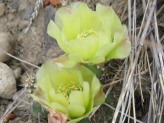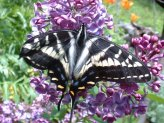Tough Beautiful Perennials for Xeriscaping
and Dry Gardens
Xeric or dry gardens are a challenging place; poor, sandy soil, extreme conditions of rain and drought, heat and cold can effectively eliminate a lot of ordinarily successful plants from the xeric garden palette.
Don’t worry, there are still lots to choose from:

Using really well adapted xeric plants can mean the difference between a garden that struggles when the dog days of summer hit, or requires a major renovation each spring as plants die from cold temperatures.
These xeriscape plants are veterans from gardens around the world, and have stood the test of time. (This link opens in a new window)
Many are well known from our grandparent’s time, planted for their admirable qualities of low maintenance, iron tough constitution and beauty.
Many attract bees and butterflies to our gardens, or supply us with flavorings for cooking, tea or medicinal purposes.
Most are pest and disease resistant, easy to propagate and pass along to friends and neighbors, and low maintenance.
Some reseed themselves, finding their own nooks and crannies and giving us delight in the surprise of seeing the seedlings in gravel walkways, patios or among other xeric plants.
The xeric plants listed below are hardy, and although they can take the low temperatures of Zone 4 to 5 on the Canadian plant hardiness zone map they are equally easy to grow in dry hot conditions.
The short list of favorite perennial plants that love dry situations;

Achillea species are one of the most recognized xeric plants with their flat landing pad clusters of blooms.
Many varieties are grown; Achillea filipendulina ‘Moonshine’ is one of the better known, along with the many varieties of Achillea millefolium – named varieties include ‘Summer Pastels’ in all shades of pale gold, soft pink and peachy salmon; ‘Cerise Queen’, deep
maroon fading to a softer pink; ‘Paprika’ is a dark brick red with pale yellow centers on each individual floret.
All do exceptionally well in dry conditions – pinch the foliage and smell it for one of the hints to a drought tolerant plant – the pungent aroma from the oils which prevent dehydration in dry conditions.

Agastache also has the distinctive odour characteristic of this group – although not pleasantly minty, more of a skunky scent.
Agastache of many species and varieties are very attractive to bees, which continually visit over the two or three weeks of bloom.
This is a good plant for the back of a border, due to its habit of leaning on its neighbors.
Once the blooms have finished, trim back the leggy stems and it disappears until the next season.

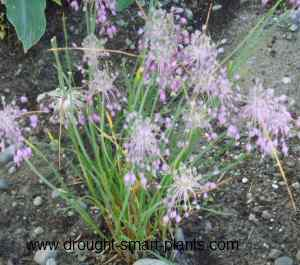
Allium are a frequently ignored and highly underused xeric plant, probably due to their unfortunate scent.
The onion and garlic plants from the potager garden or kitchen garden are close relatives to the ornamental onion tribe.
Allium shoenaprasum is the common chives, which are commonly chopped and added to egg salad sandwiches for a hit of flavor.
Other species and varieties come in all shapes, sizes and colours of bloom, from the huge Allium giganteum with pom poms of dark purple held over a meter off the ground, to the miniscule rock garden types like Allium moly with its starry golden flower clusters.
Allium cernuum, the nodding onion, is one of the most loved wildflowers with it’s clusters of downward facing blooms in soft pink to purple.

Known by the unfortunate common name of Wormwood, this family is the source of the liqueur Absinthe, said to drive the addict to insanity. Luckily, as a garden plant, the positive attributes outweigh the bad, and won’t likely lead to lunacy.
A drought tolerant and hardy little sub shrub, Artimesia ‘Silver Mound’ can be neglected and abused, then pruned hard right back to the ground, only to emerge with brand new finely cut fronds of foliage which accent many other flowering plants. The pale lemon flowers of Artimesia of all kinds are generally not spectacular, and can be trimmed off.

With funny common name like ‘Pigsqueak’ you most likely wouldn’t expect such a well behaved and civilized plant.
Rubbery leaves, which when rubbed together give rise to the common name, tend to be upright in droughty conditions, and flatten out with more moisture.
Bees love the clustered bell shaped bright magenta blooms held on a thick spire.

Catananche caerulea, for unknown reasons. Maybe because it’s blue, and we love blue flowers.
This unassuming plant just keeps coming back for more, and slowly spreading into more of a ground cover than a single
The flowers are similar to some of the knapweed family, Centaurea, but its growth habit is a lot less invasive.

Most people don’t realize that many of the Clematis species such as Clematis macropetala are extremely hardy, drought tolerant, and easy to grow from seed.
Unlike their flashier cousins, Clematis macropetala have a resistance to their nemesis, verticillium wilt, which regularly cuts down many of the large flowered hybrids and cultivars, leaving this form untouched.
Planted at the base of a small tree or some type of rustic gazebo, twiggy archway or twig fan trellis for support, these great vines make a delicate tracery of growth with clouds of pink, white or blue flowers for at least two weeks in early June, attracting many hummingbirds and big bumblebees to gather the nectar.
Silky seed clusters add a longer season of interest through the fall and winter.
The wild blue clematis native to many areas in Southern British Columbia, goes un-noticed until it produces many exquisite pale sky blue flowers in early summer – as the first to start blooming, it’s a sight for sore eyes to spot the delicate blooms scrambling up a wildlife tree or a shrub in the hedgerow.

Another thistly looking plant with great attributes is Echinops ritro – although the leaves look prickly, they are soft instead.
The globe-like flower heads attract many bees to visit.
If allowed to self seed, it will emerge in exactly the right place to make a statement, without being too pushy about it, and if it’s not wanted, the seedlings are easy to pull out.

Garden geraniums are a different genus from the tender geraniums we all know and love as potted plants for using in containers for the summer – Pelargonium species.
The Geranium genus is hardy, easy to grow and well behaved, growing in clumps of loose zoned foliage, with many strangely shaped flowers held on wiry stems in June and July.
Bees also will visit these, as well as many other pollinators.
Geranium ‘Johnson’s Blue’ is one of many lovely versions – the striped flowers of Geranium cinereum ‘Ballerina’ cover the dwarf clump of foliage, while the large and sprawling Mourning Bride has the most zoned or coloured of all, with a dark maroon horseshoe shape on each leaf.

Heuchera is one of those genera that caught the eye of many designers several years ago due to the ease of hybridizing it, leading to many new releases with radical leaf patterns, veining, and metallic patina.
For the most part, Heuchera are very easy to grow, increasing by making new crowns which can be cut off to make a whole new plant, but not requiring this treatment if you prefer a larger clump.
If the beautiful foliage isn’t enough for you, tall minaret like spires of bee attracting tiny blooms will emerge, like fairy towers.

One of those old time country garden favorites that never completely go out of style, Hyssopus officianalis has been grown for centuries for medicinal purposes, as well as a favorite plant for bees.
Small textured, always fresh looking this is a staple in my xeric garden. Almost shrublike with its wiry stems, it also responds well to hard pruning.
The small tubular pink or white flowers attract bees and hummingbirds.

Everyone knows what Iris look like, and this one is the typical three and three – three stands and three falls.
Each fall is bearded with a fuzzy different coloured stripe, giving rise to its common name of Bearded Iris.
Many colours, heights and even fragrant Iris can fill almost any niche in the sunny border.
Even once the flowers have faded, the blue green sword like foliage adds a great spikey texture.

Iris sibirica has long slender grass like foliage, and tends to do very well in shallow pond edges, but is equally at home in a more shaded dry border.
Although not technically a xeric plant, it’s so adaptable to different conditions that it’s included here. Try it in a rain garden or in with other bog plants.
Delicate slender stems hold up bird like blue, pink or white flowers with lots of veining known as ‘bee guides’.
The interesting seed pods can be used in dried flower arrangements.

Lavender needs no introduction – is there anyone who has not smelled the glorious perfume of this amazingly tough sub shrub, the essential oils released in the warm sun of June?
Bees love lavender almost as much as humans, making a distinctively flavored honey with the nectar.
Used for centuries as a moth repellent in clothing in sachets and pot pourri, this favorite drought tolerant plant is rightfully beloved.
Any time I smell lavender, its evocative scent takes me right back to the very first of many xeric gardens I visited as a child – to Anne Hathaways Cottage.
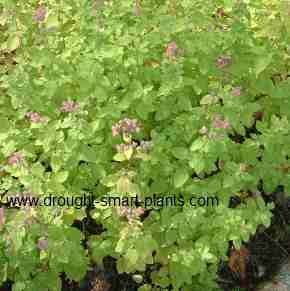
Oreganum is one of those xeric plants that until fairly recently was ignored in all settings but the herb garden.
Fortunately, some breeders have taken up the challenge to find new and improved varieties and species of this excellent plant for ornamental as well as culinary uses.
Used primarily as a seasoning in Italian cooking, Oreganum is also a prime bee attracting plant.
Blooms that open in sequence give foraging bees and pollinators a long season to collect the nectar and pollen of these great and highly underutilized plants.

Penstemon of all kinds are some of the favorite plants for bees, which immerse themselves completely in the tubular flowers.
Most of the species types are blue to purple flowered, with garden hybrids in many shades of pink, red, blue and white.
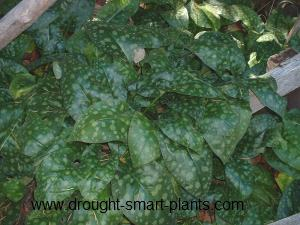
Pulmonaria, or as it’s sometimes not very romantically referred to, Lungwort (it was thought that the leaves looked like diseased lungs) is another of those highly underused plants.
It truly has the most amazing blooms – starting out blue, they fade over time to pink, giving a multi coloured effect.
The foliage is rough textured, but with new varieties showing up, can be fantastically splashed or spotted.
Used in darker corners they bring light to the dimness. They are one of the few xeric plants that thrive in dry shade, and look spectacular alongside ferns and Gallium odoratum, the sweet woodruff.
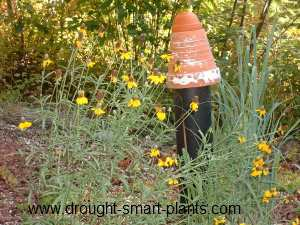
The Mexican Hat as its known has the most intriguing flowers – almost like a small yellow Echinacea or Rudbeckia bloom.
Very tough and although a little stringy, the abundance of the blooms and the length of time they stay in flower make this a worthwhile plant for a neglected site.
Often seen in wildflower seed mixes.

Sparkling with water drops after a rain shower, this is the prettiest sight.
The blue green lobed leaves of Ruta graveolens, the Rue plant seem to be in a state of suspended growth as they are always fresh looking.
Once the plant gets big enough in time, greenish flowers emerge and apparently are a favorite of the Swallowtail butterfly. It’s worth growing just for that.
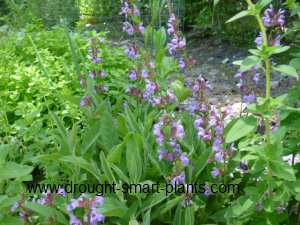
Salvia officianalis is the culinary sage – another transplant from the herb garden.
Blue purple blooms like tiny orchids will open in sequence all the way up the stem in the summer, and attract hummingbirds and big bumblebees in droves.

Stachys lanata is the Lambs Ears – well named as they are as soft and fuzzy as a newborn lamb.
They also hang down on the stem, resembling many little ears.
Happily reseeding itself wherever it can find a quiet corner, this plant is never a nuisance.
Unwanted seedlings can be easily removed, and the whole plant can be pruned back to be refreshed if it gets untidy in late summer.
As an added bonus, the foliage if crushed smells exactly like lemonade.

This list would not be complete without at least one Thyme – this is Mother of Thyme, the largest of the clan, included here for its attraction for bees, and also its tenacity.
Grown in the poorest of soil with never a splash of water, this is one tough plant.

The lovely and highly scented native violet is well worth growing in shady corners under ferns or other larger plants.
Highly adapted to sandy and well drained conditions it’s happiest with a mulch of chopped leaves.
It will reseed itself either from seeds set on the pretty purple flowers here, or on its strange underground blooms which don’t require pollination – a survival skill seldom copied.
As if that weren’t enough, it’s also the host plant for caterpillars of the Great Spangled Fritillary Butterfly.
This list is by no means complete – there are many other worthy plants that are renowned for drought tolerance, hardiness and beauty, but these are a few of the xeric plants that are exceptional in my growing conditions – maybe they’ll do as well for your in your xeric garden.
See Keppel Croft Gardens for more xeriscape plants (opens in a new window) and see my list of 10 Best Xeric Plants for some great suggestions to start with.






